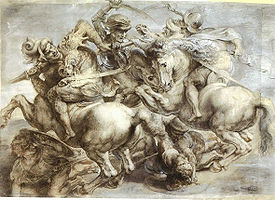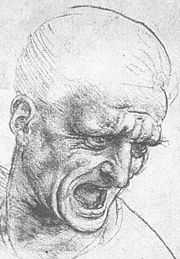
The Battle of Anghiari (painting)
Encyclopedia

Leonardo da Vinci
Leonardo di ser Piero da Vinci was an Italian Renaissance polymath: painter, sculptor, architect, musician, scientist, mathematician, engineer, inventor, anatomist, geologist, cartographer, botanist and writer whose genius, perhaps more than that of any other figure, epitomized the Renaissance...
at times referred to as "The Lost Leonardo", which some commentators believe to be still hidden beneath later frescoes in the Hall of Five Hundred (Salone dei Cinquecento) in the Palazzo Vecchio
Palazzo Vecchio
The Palazzo Vecchio is the town hall of Florence, Italy. This massive, Romanesque, crenellated fortress-palace is among the most impressive town halls of Tuscany...
, Florence
Florence
Florence is the capital city of the Italian region of Tuscany and of the province of Florence. It is the most populous city in Tuscany, with approximately 370,000 inhabitants, expanding to over 1.5 million in the metropolitan area....
. Its central scene depicted three men riding raging war-horses engaged in a battle for possession of a standard, at the Battle of Anghiari
Battle of Anghiari (1440)
The Battle of Anghiari was fought on June 29, 1440, between Milan and the Italian League led by Republic of Florence in the course of the Wars in Lombardy....
in 1440.
Many preparatory studies by Leonardo still exist. The composition of the central section is best known through a drawing by Peter Paul Rubens in the Louvre
Louvre
The Musée du Louvre – in English, the Louvre Museum or simply the Louvre – is one of the world's largest museums, the most visited art museum in the world and a historic monument. A central landmark of Paris, it is located on the Right Bank of the Seine in the 1st arrondissement...
, Paris
Paris
Paris is the capital and largest city in France, situated on the river Seine, in northern France, at the heart of the Île-de-France region...
. This work, dating from 1603 and known as The Battle of the Standard, was based on an engraving of 1553 by Lorenzo Zacchia, which was taken from the painting itself or possibly derived from a cartoon by Leonardo. Rubens succeeded in portraying the fury, the intense emotions and the sense of power that were presumably present in the original painting. Similarities have been noted between this Battle of Anghiari and the Hippopotamus Hunt painted by Rubens in 1616.
History


Gonfaloniere of Justice
Gonfaloniere of Justice was a post in the government of medieval and early Renaissance Florence. Like Florence's Podestà and Priori, it was introduced in 1293 when Giano Della Bella's Ordinamenti di Giustizia came into force....
Piero Soderini
Piero Soderini
Piero di Tommaso Soderini also known as Pier Soderini, was an Italian statesman of the Republic of Florence.-Biography:...
, a contract signed by no less than Niccolò Machiavelli
Niccolò Machiavelli
Niccolò di Bernardo dei Machiavelli was an Italian historian, philosopher, humanist, and writer based in Florence during the Renaissance. He is one of the main founders of modern political science. He was a diplomat, political philosopher, playwright, and a civil servant of the Florentine Republic...
, to decorate the Hall of Five Hundred. At the same time his rival Michelangelo Buonarroti, who had just finished his David
David (Michelangelo)
David is a masterpiece of Renaissance sculpture created between 1501 and 1504, by the Italian artist Michelangelo. It is a marble statue of a standing male nude. The statue represents the Biblical hero David, a favoured subject in the art of Florence...
, was designated the opposite wall. This was the only time that Leonardo da Vinci and Michelangelo worked together on the same project. The painting of Michelangelo depicted an episode from the Battle of Cascina
Battle of Cascina (Michelangelo)
The Battle of Cascina is an influential lost artwork by Michelangelo.-Origins:The painting was commissioned from Michelangelo by Piero Soderini, statesman of the Republic of Florence. It was intended to be a fresco painted on a wall of the Salone dei Cinquecento in Palazzo Vecchio...
, when a group of bathing soldiers was surprised by the enemy. However Michelangelo did not stay in Florence long enough to complete the project. He was able to finish his cartoon, but only began the painting. He was invited back to Rome in 1505 by the newly appointed Pope Julius II and was commissioned to build the Pope's tomb.
Leonardo da Vinci drew his large cartoon in the Basilica di Santa Maria Novella
Basilica di Santa Maria Novella
Santa Maria Novella is a church in Florence, Italy, situated just across from the main railway station which shares its name. Chronologically, it is the first great basilica in Florence, and is the city's principal Dominican church....
, depicting a scene from the life of Niccolò Piccinino
Niccolò Piccinino
Niccolò Piccinino was an Italian condottiero.-Biography:He was born at Perugia, was the son of a butcher.He began his military career in the service of Braccio da Montone, who at that time was waging war against Perugia on his own account, and at the death of his chief, shortly followed by that of...
, a condottiere in the service of duke Filippo Maria Visconti
Filippo Maria Visconti
Filippo Maria Visconti was ruler of Milan from 1412 to 1447.-Biography:Filippo Maria Visconti, who had become nominal ruler of Pavia in 1402, succeeded his assassinated brother Gian Maria Visconti as Duke of Milan in 1412. They were the sons of Gian Galeazzo Visconti, Gian Maria's predecessor, by...
of Milan. He drew a scene of a violent clash of horses and a furious battle of men fighting for the flag in the Battle of Anghiari. Giorgio Vasari
Giorgio Vasari
Giorgio Vasari was an Italian painter, writer, historian, and architect, who is famous today for his biographies of Italian artists, considered the ideological foundation of art-historical writing.-Biography:...
in his book Le Vite praised the magistral way Leonardo had put this scene on paper: "It would be impossible to express the inventiveness of Leonardo's design for the soldiers' uniforms, which he sketched in all their variety, or the crests of the helmets and other ornaments, not to mention the incredible skill he demonstrated in the shape and features of the horses, which Leonardo, better than any other master, created with their boldness, muscles and graceful beauty."
Leonardo built an ingenious scaffold in the Hall of Five Hundred that could be raised or folded in the manner of an accordion
Accordion
The accordion is a box-shaped musical instrument of the bellows-driven free-reed aerophone family, sometimes referred to as a squeezebox. A person who plays the accordion is called an accordionist....
. This painting was to be his largest and most substantial work. Since he had a bad experience with fresco
Fresco
Fresco is any of several related mural painting types, executed on plaster on walls or ceilings. The word fresco comes from the Greek word affresca which derives from the Latin word for "fresh". Frescoes first developed in the ancient world and continued to be popular through the Renaissance...
painting (Last Supper; refectory of Santa Maria delle Grazie, Milan), he wanted to apply oil colours on the wall. He began also to experiment with such a thick undercoat (possibly mingled with wax), that after he applied the colours, the paint began to drip. Trying to dry the painting in a hurry and save whatever he could, he hung large charcoal brazier
Brazier
A brazier is a container for fire, generally taking the form of an upright standing or hanging metal bowl or box. Used for holding burning coal as well as fires, a brazier allows for a source of light, heat, or cooking...
s close to the painting. Only the lower part could be saved in an intact state. But the upper part couldn't dry fast enough and the colours intermingled. Leonardo then abandoned the project.
Michelangelo's and Leonardo's unfinished paintings hung in the same room together for almost a decade (1505-1512). The cartoon of Michelangelo's painting was cut in pieces by Bartolommeo Bandinelli
Bartolommeo Bandinelli
Bartolommeo Bandinelli, actually Bartolommeo Brandini , was a Renaissance Italian sculptor, draughtsman and painter.-Biography:...
out of jealousy in 1512. The centerpiece of The Battle of Anghiari was greatly admired and numerous copies were made for decades.
In the mid-16th century (1555-1572), the hall was enlarged and restructured by Vasari and his helpers, so that Grand Duke Cosimo I could hold his court in this chamber. During this transformation, famous (but unfinished) works were lost, including The Battle of Cascina by Michelangelo and The Battle of Anghiari by Leonardo da Vinci.
Possible recovery
Maurizio SeraciniMaurizio Seracini
Maurizio Seracini is a diagnostician of Italian art. A '73 UCSD Alumnus, graduated in bioengineering from the University of California, San Diego , he founded, in 1977, the first company in Italy for diagnostic and non-destructive analyses on art and architecture, the Editech srl, Diagnostic Center...
, an Italian expert in high-technology art analysis, believes that behind one of these murals by Vasari, the "Battle of Marciano in Val di Chiana" (1563), is hiding the original fresco of Leonardo da Vinci. On top of Vasari's fresco, 12 meters above the ground, a Florentine
Florence
Florence is the capital city of the Italian region of Tuscany and of the province of Florence. It is the most populous city in Tuscany, with approximately 370,000 inhabitants, expanding to over 1.5 million in the metropolitan area....
soldier waves a green flag with the words "Cerca trova" ("He who seeks, finds"). These enigmatic words seem to be a hint by Vasari, who always spoke highly of the fresco of Leonardo da Vinci.
Seracini believes it is unlikely that Vasari would have destroyed the work of his predecessor during his renovation of the Hall of Five Hundred. Using non-invasive techniques, such as a high-frequency, surface-penetrating radar and thermographic camera, Seracini made a survey of the hall. Among other conclusions, he found out that Vasari had built another wall in front of the east wall where the original fresco of Leonardo da Vinci was reported to be located. He found a gap of 1 to 3 centimeters between the two walls, large enough for the older fresco to be preserved.
Since early 2007, the city council of Florence and the Italian Minister of Culture have given the green light for further investigation. However, no new discoveries have been made yet.

